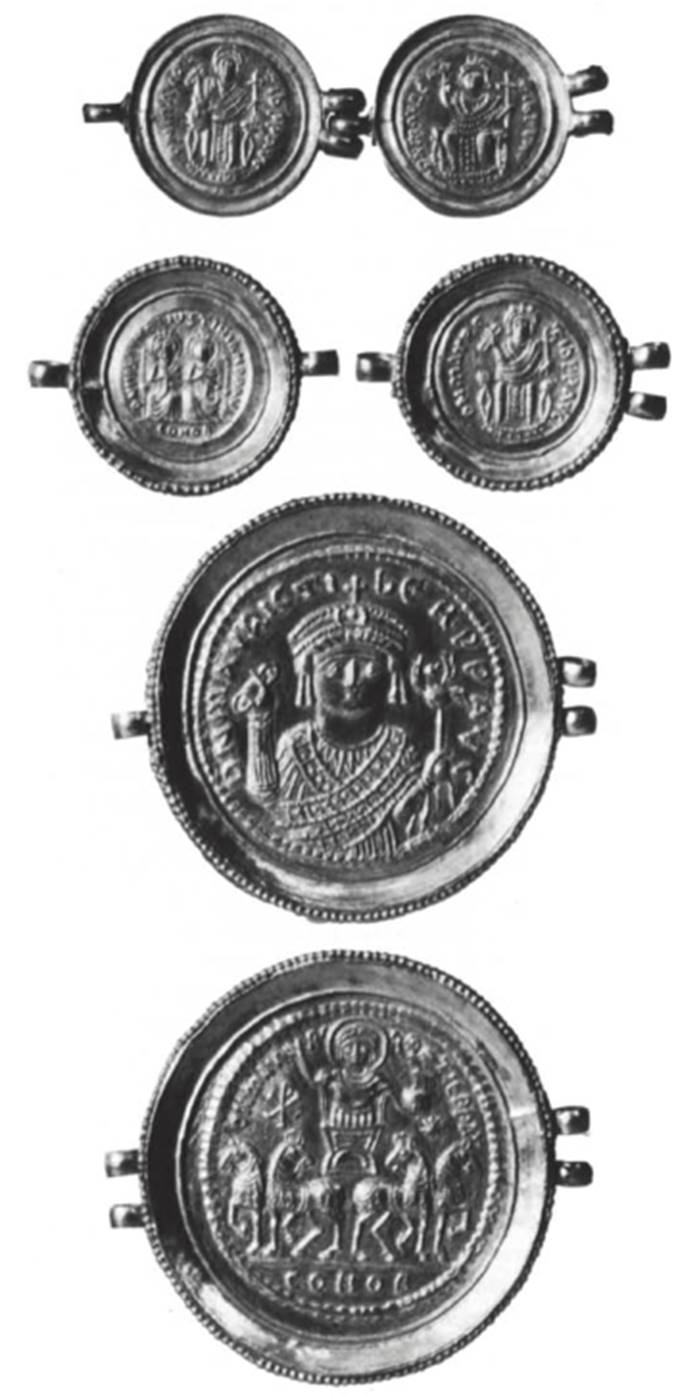Girdle of coins and medallions. Constantinople (?), 583. Gold
A girdle composed of twelve solidi and four medallions, each set into a smooth gold frame with plain hoop links. All bear the mint mark CONOB (Constantinople obryzum—"pure gold of Constantinople"), suggesting, though not proving, manufacture in the capital. Each medallion and four of the coins have double beaded edges. The girdle now lacks the clasp and several coins. The order of the pieces and the attachment pins are modern.
The four medallions are identical, struck from the same dies (Grierson, 1955, p. 59). The obverse shows a frontal bust of the emperor Maurice Tiberius, wearing trabea, cross-topped crown, and pendulia, holding the mappa in his right and an eagle-topped scepter in his left hand. The legend reads D(ominus) N(oster) MAVRic(ius) TiBER(ius) p(ater) p(atriae) AVG(ustus). On the reverse, with a more abbreviated legend, the emperor is shown standing frontally in a chariot, in military dress, crown, pendulia, and halo, with a crown-offering victoriola on a globe in his left hand and his right raised. The four horses are elaborately caparisoned and appear in a symmetrical design common on consular medallions. A serified Chi Rho and an eight-pointed star fill the spaces above the horses' heads.


Some of the coins are of previous emperors: one of Theodosius II (bust), three of a joint issue of Justin I and Justinian, 527, (one of Justin II and Tiberius II, 578, in the Cyprus Museum, Nicosia); and eight consular solidi of Maurice. The coins were probably a gift from the emperor, on his accession to office of consul, to some high official or noble, who had them fashioned into a girdle for easy display. Such largesse was traditional and could be given in specie or precious objects, such as diptychs or medallions (cf. no. 46). Because this girdle weighs almost three quarters of a pound and was found with the Second Cyprus Treasure (A. and J. Stylianou, 1969), its recipient may well have been governor of a province.
The four consular medallions and eight of the solidi were struck on the occasion of one of Maurice's two consulships—583 or 602. Grierson at first (1955) preferred the later date but changed this opinion (1961) after considering the medallions' stylistic and technical affinities with the Dumbarton Oaks Collection Epiphany medallion (no. 287) from the same treasure and the date, 584, he gave it.
The reason for the burial of the treasure was most likely the Arab attack on Lapithos, Cyprus, in 653-654. It was discovered near there, at the modern village of Lambousa, near Karavas, in February 1902.
Bibliography: Grierson, 1955; Grierson, 1961; A. and J. Stylianou, 1969, pp. 49-53, 64, no. 16, figs. 37-39.
Date added: 2025-07-10; views: 172;
